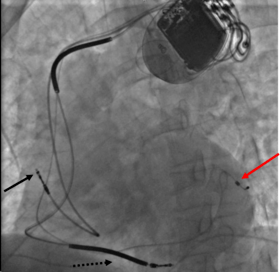Cardiac resynchronization therapy
| Cardiac resynchronization therapy | |
|---|---|
 | |
| ICD-9-CM | 00.51, 00.54 |
| MeSH | D058409 |
| eMedicine | 1839506-devices |
An implanted cardiac resynchronization device is a medical device used in cardiac resynchronization therapy (CRT). It resynchronizes the contractions of the heart’s ventricles by sending tiny electrical impulses to the heart muscle, which can help the heart pump blood throughout the body more efficiently. CRT defibrillators (CRT-D) also incorporate the additional function of an implantable cardioverter-defibrillator, to quickly terminate an abnormally fast, life-threatening heart rhythm. CRT and CRT-D have become increasingly important therapeutic options for patients with moderate and severe heart failure.[1]
Cardiac resynchronization therapy in heart failure
Cardiac resynchronization therapy (CRT) is an effective therapy in patients with heart failure and dyssynchrony identified as a prolonged QRS duration.[2] Benefits include improved exercise tolerance, reduced remodeling (reduction in LV chamber size and measures of mitral regurgitation), reduced mortality, and reduced need for hospitalization in patients in sinus rhythm.
References
- ↑ Choi, Anthony J.; Thomas, Sunu S.; Singh, Jagmeet P. (2016). "Cardiac Resynchronization Therapy and Implantable Cardioverter Defibrillator Therapy in Advanced Heart Failure". Heart Failure Clinics. 12 (3): 423–436. ISSN 1551-7136. doi:10.1016/j.hfc.2016.03.010.
- ↑ Sardu, Celestino; Marfella, Raffaele; Santulli, Gaetano (2014). "Impact of Diabetes Mellitus on the Clinical Response to Cardiac Resynchronization Therapy in Elderly People". Journal of Cardiovascular Translational Research. 7 (3): 362–368. ISSN 1937-5387. doi:10.1007/s12265-014-9545-9.